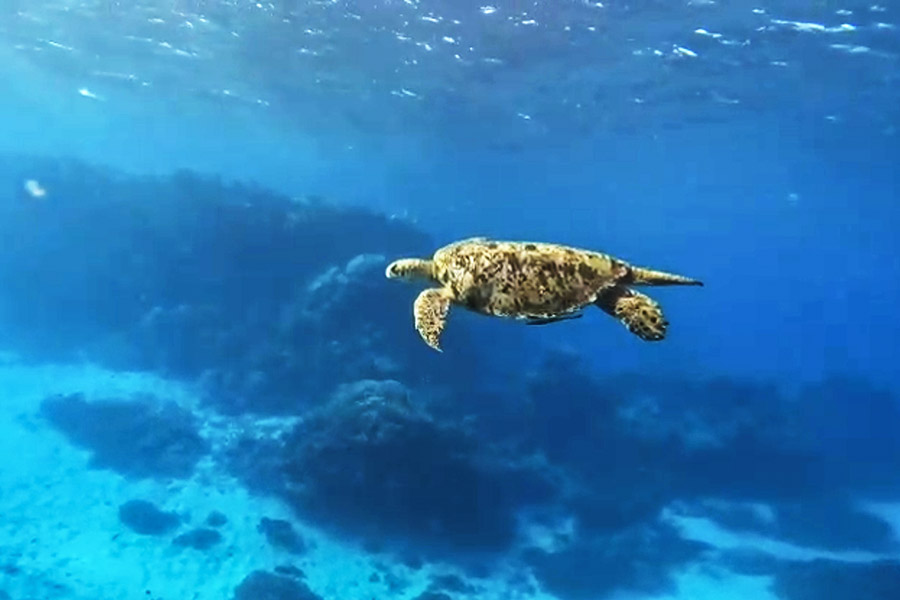By Mike Huber
It took about a week to get to Flores, Indonesia from Bali, as it is over 1,000 kilometers away. This was accomplished via three ferries and finally, a 4-day cruise. The cruise was a blast, but once aboard I realized it was a one-way cruise and I would have to find a ferry back (which could take up to 36 hours) or book a return flight to Bali. Normally this would alarm most people, but I had time to kill and quickly learned Flores was an Indonesian scuba diving mecca. Some of the most beautiful wildlife could be seen diving here. This was not a bad place to have a several-day layover.

It didn’t take long to find a scuba company. It had only been a few days since my prior dive and I was already itching to get back underwater. I chose a dive center based on its three-dives-in-one-day regimen. Most the other dive centers only offered two dives in one day. This would help rack up my dive numbers (and my experience, as I would soon learn).
Diving the Komodo Islands is just amazing on so many levels. The biggest draw is the wildlife. The second draw is the strength of the underwater currents. On an average dive we would float with the current for close to an hour and travel several kilometers during the dive. The current was a constant underwater river that was at times overwhelming, depending on the direction it was taking you.
If you got caught in a side current it would feel like you were on the Space Station and someone just cut your tether and you were floating off into nothingness. Feelings of anxiety emerged when this happened, and this caused me to go through more of my air and shorten my dive. It was always important to remain calm, move slowly, and not over-react. That’s easier said than done.
The cool part about these currents is when I was in a “controlled” area I could just watch the beautiful corals go by. The downside was if I saw a turtle or another cool species of wildlife, I really couldn’t get to it as I was swept along with the current. We were told, if possible, to get low to the ocean floor and grab a large rock as an anchor so we could enjoy the wildlife.

I took this rock grabbing suggestion as I happened upon three beautiful manta rays. They were huge, about 12 feet in width. While blowing by them in the current it was like they were in an underwater thermal hovering in place motionless unaffected by the strong currents. It was like watching a stealth fighter Jet hover. Meanwhile I was doing my best to slow down to try to remain close to them. As I descended to the ocean floor seeking refuge from the currents behind a large piece of coral, I grabbed a rock. I instantly felt something sharp on my fingers. I had accidently grabbed a sea urchin and the spines were in all my fingers to include deep under my fingernail. Almost instantly a large gushing of green fluid began pouring out of my fingers. This is when I learned you bleed green when you are deep under water.
Realizing there was nothing I could do about the bleeding until I surfaced, my focus was on watching the manta rays flying by as the current pulled me just underneath them. During this time, I religiously checked my air levels on my respirator. Once I hit 60 bar (25%) it would be time to slowly return to the surface.
We began our ascent to a 3-minute safety stop at 5 meters below the surface to allow our bodies to adjust to the pressure. At around 10 meters and still being abused by the strong currents I went to breathe in and there was nothing there. It was as though I was breathing through a straw and then suddenly someone put their finger over the end. I was out of air. This was a good time to see how much of the training I actually retained and how much of I ignored while being distracted by the beautiful scuba instructor in Australia.

More epic adventures are here!


I’m getting anxiety just reading about you bleeding green and running out of air!
exactly why im starting this rescue diver class this week. Always prepare for your worst day. 🙂
thanks bud! 🙂
Those turtles are worth the price of admission . Maybe! Lol
Cool azz prehistoric life.
really fun creatures to hang out with for sure!
I know you travel with minimal possessions but owning a Dive computer is almost a must. Setting the alarms to your personal diving style and understanding how the specific computer calculates GTR (gas time remaining..does it include or exclude safety stops for example) and TTS (time to surface.) Renting the rest of the stuff is 100% OK and adding your computer with high pressure hose to a rented reg is easy. Good luck with the safety course, Science of Diving is good also as it gives insight on the forces, pressure and gas bubble impacts of diving and how to mitigate. Dive on.
I’m going to purchase one soon I think. Thanks for ideas.
can’t to hear how this turns out!